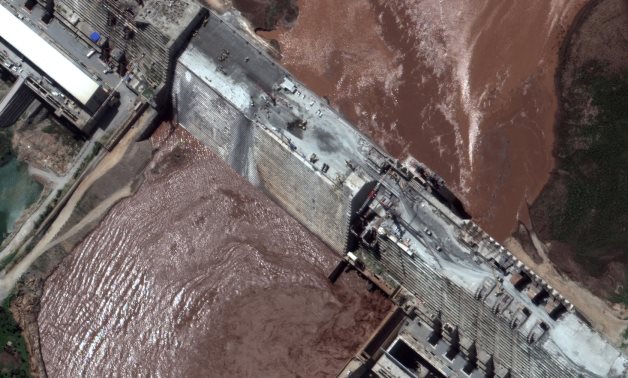
A handout satellite image shows a closeup view of the Grand Ethiopian Renaissance Dam (GERD) and the Blue Nile River in Ethiopia June 26, 2020. Satellite image ©2020 Maxar Technologies via REUTERS
CAIRO – 29 August 2020: Egypt and Sudan announced that the last round of negotiations that was held on Friday with Ethiopia over the controversial Renaissance dam reached stalemate.
In a statement issued by the Egyptian Ministry of Irrigation and Water Resources on Friday, Egypt said the three technical and legal committees of every country did not reach consensus on the points of contention regarding the operation of the dam the filling process of the reservoir in the initial draft that included the three parties’ proposals.
Egypt added that the draft was not referred yet to the African Union, the main broker of these rounds of negotiations.
“After a long discussion regarding the course of negotiations in coming period, the water ministers [of the three countries] agreed -at the end of the meeting - that each individual country would send a letter to the South African president [the current chairperson of the AU] on its vision for the next stage of negotiations,” the Egyptian ministry’s statement read.
The Sudanese Ministry of Irrigation and Water Resources announced on Friday that the three parties failed to reach consensus and to have a unified draft of their proposals concerning the points of the disagreement.
“After an accurate evaluation of the development of the negotiations and after a review of the expert groups’ work over the past days, the process of merging the three drafts would stumble,” the statement read.
“The continuation of negotiations in this current form will not lead to achieving practical results,” said Sudanese Minister of Water Resources and Irrigation Yaser Abbas in the statement.
As for Ethiopia, the Ministry of Water, Irrigation and Energy announced in a statement that the three countries would submit their respective updated drafts to the Chairperson of the AU Executive Council Dr. Naledi Pamdor, the South African Minister of International Relations and Cooperation.
Ethiopia also announced that the next round of the negotiations is expected to convene on September 14, 2020 upon a confirmation from Sudan.
This round of negotiations, which has started on August 18, 2020, was attended by Representatives from the AU, EU, and the USA.
The US administration decided to cut foreign aid to the Ethiopian government over the dispute between the three countries, reported Foreign Policy magazine on Friday.
The plan, which was approved by US Secretary of State Mike Pompeo, could suspend about $130 million from the aid, the magazine reported US officials and congressional aides.
Washington had brokered a tripartite discussion between the three countries, in presence of the President of the World Bank (WB) starting from November 6, 2019 until February 27 and 28 when Ethiopia apologized for being absent from the negotiations. During these rounds of talks, tangible outcomes were agreed on among the three parties concerning the rules and mechanism of operating the dam and the filling process of the reservoir during the drought and prolonged drought; however, the Ethiopian and Sudanese refused to sign the US/WB-drafted deal.
Few months later, the African Union resumed the talks in July, but nothing was reached due to Ethiopia’s intransigence towards signing a legal binding agreement regulates the operation and filling process among the three countries to avoid possible harms against Egypt and Sudan.
Since May 2011, Cairo has voiced its concern over how the dam can reduce the country’s annual shares of 55.5 billion cubic meters of Nile water. Egypt’s average water per-capita is expected to drop from 663 cubic meters per year to 582 cubic meters by 2025, according to the Central Agency for Public Mobilization and Statistics (CAPMAS) in 2014.
Constructions in the Grand Renaissance Dam started on April 2, 2011 at a cost of $4.8 billion. It was built by the Italian construction and engineering company Salini Impergilo. The Italian company is headquartered in Milan. The dam is located on the Nile with a capacity of 74 billion cubic meters, and is expected to generate up to 6,000 megawatts of power.
Comments
Leave a Comment